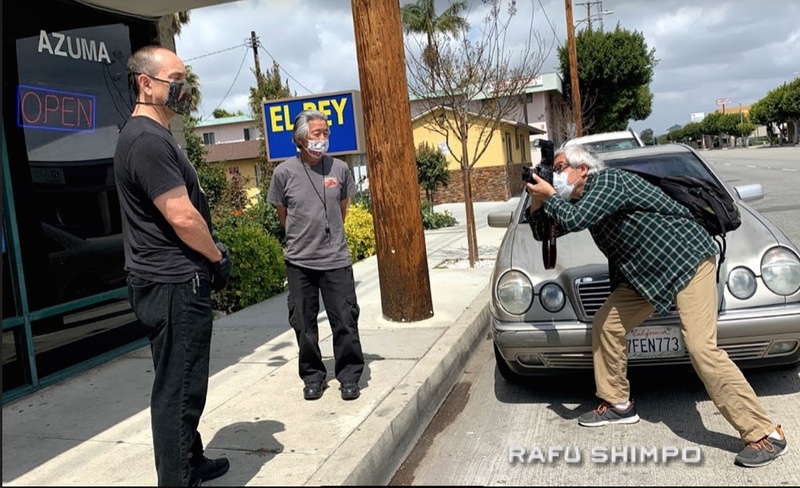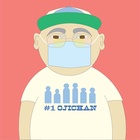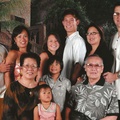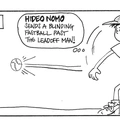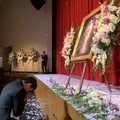This is how I go cover a story now. I put on a cloth mask and wash my hands, grab my recorder and put an LAPD press badge around my neck. A while back, photographer Mario Gershom Reyes and I covered Hideki Obayashi of Azuma in Gardena as he fights to keep the restaurant going.
Even with masks on, you can see the strain, exhaustion and worry in his eyes. His wife Genie Nakano stopped by with a tin box of cookies. Our hands are all worn, chapped and dry from constant washing. Places where we meet are now empty, the chairs placed on tables, stacks of boxes piled up. Behind the scenes are uncertainty and bills and more bills.
On the way to Azuma, I noticed a line of cars on 161st Street, maybe 20 or so long. They were all lined up for a food drive at the Gardena Genesis Community Church. As I walked up to the parking lot, a guard yelled sternly for me to stop. “No walk-ins allowed!” he hollered.
I waved my press ID: I’m simply here to cover the story.
It seems so strange. I’d say our normal stories have nothing to do with security guards and tense exchanges, but these aren’t ordinary times.
Once I entered, it wasn’t so bad. Everyone waiting was very polite and grateful. The volunteers in PPE were putting together bags of food. Folks had traveled from far away; a man in a sweat-stained cowboy hat said he took two buses.
Pastor Filemu Filemu was open and kind: the leader of a small church trying to meet the needs of the hungry. There are so many, the needs are beyond any one church, but they are doing what they can. I feel with every story we write, we are trying to help one restaurant or organization during this terrible time. What else can any of us do right now, but try?
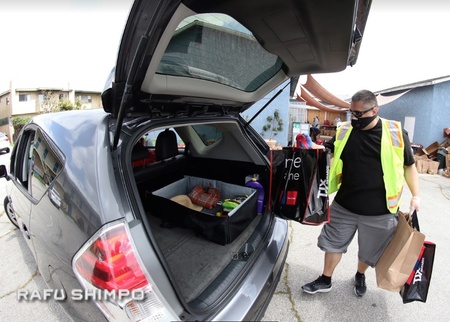
This is the 117th year of The Rafu Shimpo and my 20th year here come October. What you are holding has been the record of a community since three Issei who attended USC understood that this is what was needed to keep people together, informed and united.
The Rafu has weathered the 1918 pandemic, two world wars, the Great Depression, the forced removal and incarceration of Japanese Americans. It is made of paper, remarkably fragile, with a tendency to yellow and tear, but it is also remarkably strong. Most of the men and women who worked on this publication are gone, but their words remain.
It struck me on our last Friday at the office that what we as a newspaper and a community do in this moment will be studied and remembered by future generations. How did we manage to survive this crisis? What did we hold on to and cherish? What was lost?
The question I come back to is: will Rafu remain?
We are often asked, “How is The Rafu doing?” The answer right now is best summed up by Ellen Endo, who has been a guiding hand at The Rafu since she was a teenager working for Aki Komai: “This may have been The Rafu Shimpo’s roughest month but oddly the most rewarding. Working far apart, we’ve never been closer.”

I am an optimistic person, so my view has always been that if the need is there, then somehow there will be a way. But the outlook has never been more severe. The newspaper survived previous moments of crisis in 2008 and 2016 without truly evolving the old business model of advertising and subscriptions, now print and digital. In fairness, few publications have managed to fundamentally change their revenue stream. Will this latest crisis deliver a knockout punch?
I still go back to the moment when scientist/philanthropist Dr. Paul Terasaki asked me to set up a meeting with publisher Michael Komai to discuss ways he could help the publication. For years, I had known Dr. Terasaki as one of my stepdad Mas Uriu’s fellow doctor pals; only later did I come to know of his many accomplishments.
The end result of the meeting with Dr. Terasaki was he purchased four subscriptions for his kids. That is a good thing, but I would like to think if that meeting happened at this moment in history, there would be other avenues for individuals such as Terasaki to offer more assistance, that would not only sustain a struggling 117-year-old newspaper but allow it to evolve and flourish, to properly pay staff and contributors, and update old equipment. Besides reporting on now non-existent sporting events, Mikey Hirano Culross has been keeping our computers going in whatever MacGyver-esque way possible.
Since the pandemic began, a casualty has been community newspapers across the country. In quick succession, the Glendale News-Press, La Canada Valley Sun and Burbank Leader succumbed to years of declining advertising revenue. COVID-19 was the final push towards oblivion.
Rep. Adam Schiff (D-Burbank) mourned the losses as “a threat to democracy.”
Schiff continued: “Though there are no easy answers, I believe it is important that Congress examine ways we can support local journalism of the sort the News-Press, the Leader and the Sun have practiced for many years.”
It is with great appreciation that Rafu was one of just 26 publications in California selected to receive a grant from Facebook this week as part of an initiative to help the content creators that are local newspapers.
For small ethnic newspapers, the threat of extinction is even greater. The communities they serve are more vulnerable and the need is greater for in-language, accurate and up-to-date information. For Asian Americans, there is a greater sense of isolation now as we find ourselves targeted, attacked, and scapegoated for this dreadful pandemic.

These days I’ve been doing a lot of Zoom briefings, which give you the opportunity to see fellow journalists, all sheltering at home. We are Asian, Latinx, African American, Pacific Islander, first generation and generations removed from the homeland — we may not garner Pulitzers, but we serve as an important, trusted source of information.
I am most proud during my time as editor of The Rafu of the talented journalists who we’ve been able to mentor, whose work has appeared in these pages. Journalists such as Samantha Masunaga, Elise Takahama, Matthew Ormseth, Daniel Sato, Mia Nakaji Monnier, and Nao Nakanishi have gone on to larger publications, with broader outreach. They may now cover mainstream news, but they cut their teeth interviewing Nisei Week queens and spending weekends dancing “Tanko Bushi” and eating Okinawan dango at Obon festivals.
Small ethnic community papers serve as incubators for young journalists to hone their skills. This is an important mission in an era of “fake news” and open, virulent racism.
When this crisis is over, a different Japanese American community will emerge. Some institutions will no doubt disappear, others will adapt, possibly merge and find their missions have changed with the new needs that have arisen.
I feel that for a stronger Japanese American community at the end of this long tunnel, a publication like The Rafu must be there to do what it always has done: celebrate our victories, mourn our losses, connect and amplify our differing voices and opinions, and offer accountability of the higher powers of society.
The hardest, most important part of my job is helping to manage our obituary section. It takes a team of us, working closely with family members and the staffs of mortuaries, who after so many years, we know on a first-name basis.
Last week, I opened my email, read an obit and broke down weeping. The stress of these past weeks — the difficulties of doing this job from home, hitting our deadline, pushing that rock up the hill every day — it all got to me in the poignant tribute to a member of this community. Another friendly face, a loved one who had died, in this case of COVID-19.
The tender task we take to now, in our small capacity, is to help offer some comfort to grieving loved ones, unable to gather together to mourn, to share a hug, to offer our memories of the deceased. We gather together on the pages of this publication, as we have for more than a century.
In this moment when grief and death have never been more present in our day-to-day lives, this is the task we take to, as a community, as a newspaper, for as long as we can.
That matters.
*This article was originally published in The Rafu Shimpo on May 16, 2020.
© 2020 Gwen Muranaka


